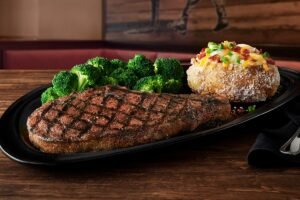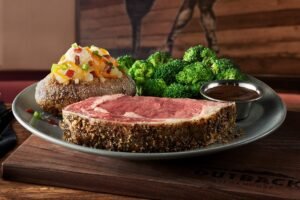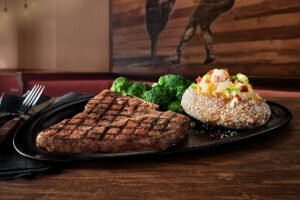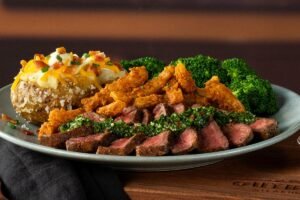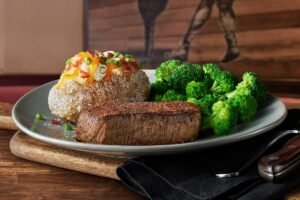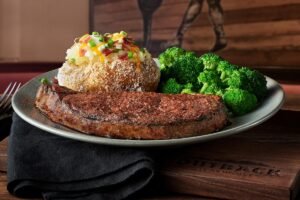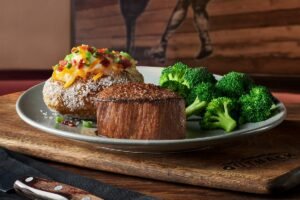Outback Steakhouse built its reputation on one fundamental promise: serving quality steaks that deliver bold flavors without the pretense of white-tablecloth dining. Since 1988, the chain has perfected its approach to steak preparation, combining USDA Choice beef cuts with proprietary seasoning blends and precise cooking techniques that have earned them a devoted following across America.
The signature steaks menu represents the heart of Outback’s culinary identity. Each cut undergoes careful selection, aging, and preparation processes that transform premium beef into memorable dining experiences. From the perfectly marbled ribeye to the tender center-cut sirloin, these steaks showcase why Outback remains a dominant force in the casual dining steakhouse category, serving over 65 million steaks annually across their 700+ locations.
Outback Steakhouse Signature Steaks Menu
Outback’s Steak Preparation
Sourcing and Selection Standards
Outback’s beef procurement process involves partnerships with specific ranches and suppliers who meet stringent quality criteria. All signature steaks come from USDA Choice grade beef, representing the top 15% of all graded beef in America. The cattle are grain-fed for a minimum of 120 days, developing the marbling essential for flavor and tenderness.
The selection process at distribution centers involves hand-inspection of every case of beef. Steaks must meet specific marbling scores, color standards, and size specifications before approval for restaurant delivery. This quality control system rejects approximately 8% of beef that doesn’t meet Outback’s standards.
The Aging Process
Outback employs a wet-aging process for their signature steaks, storing vacuum-sealed cuts at precisely 34-38°F for 21-28 days. This controlled aging breaks down muscle fibers through natural enzymatic processes, resulting in increased tenderness and concentrated flavor development. The wet-aging method retains moisture better than dry-aging, ensuring juicier steaks while maintaining portion weights.
Proprietary Seasoning Development
The signature Outback seasoning blend took two years to perfect, involving 187 test batches before finalizing the recipe. This blend contains 17 different spices and herbs, including smoked paprika, garlic powder, onion powder, black pepper, cayenne, and several proprietary ingredients that remain closely guarded secrets. Each restaurant receives pre-mixed seasoning from a single supplier to ensure consistency across all locations.
Temperature Precision and Cooking Methods
The Searing Process
Outback’s grills operate at temperatures between 450-550°F, creating the Maillard reaction responsible for the characteristic crust on their steaks. This chemical reaction between amino acids and reducing sugars produces over 600 different flavor compounds, contributing to the complex taste profile of properly seared beef.
Grill masters undergo 80 hours of training specifically on steak preparation, learning to identify doneness through touch, appearance, and timing rather than relying solely on thermometers. The signature cross-hatch grill marks require rotating steaks at 45-degree angles precisely halfway through each side’s cooking time.
Wood-Fire Enhancement
The use of oak wood in Outback’s grilling process adds subtle smoke flavors that complement rather than overpower the beef’s natural taste. Oak burns at consistent temperatures around 900°F, producing minimal ash while imparting mild, sweet undertones. Each restaurant uses approximately 50 pounds of oak wood daily, sourced from sustainable forestry operations.
Rest Period Protocol
Every steak undergoes a mandatory 3-5 minute rest period after grilling, allowing internal juices to redistribute throughout the meat. This process prevents moisture loss when cutting, ensuring each bite maintains optimal juiciness. During this time, carryover cooking raises the internal temperature by 5-7 degrees, achieving the desired final doneness.
Nutritional Profiles and Dietary Considerations
Caloric and Macronutrient Breakdown
The signature steaks range from 280 calories (6 oz. Victoria’s Filet) to 1,140 calories (22 oz. Bone-In Ribeye), not including sides or toppings. Protein content averages 7 grams per ounce of cooked steak, making these cuts excellent sources of complete proteins containing all essential amino acids.
Iron content in Outback’s steaks provides 15-35% of daily recommended values per serving, with heme iron from beef offering superior bioavailability compared to plant sources. The zinc content supports immune function, while B-vitamins, particularly B12, contribute to energy metabolism and neurological health.
Customization for Dietary Needs
Outback accommodates various dietary requirements through modification options. All steaks can be prepared without seasoning for sodium-restricted diets, reducing sodium content by approximately 65%. Gluten-free preparation involves using dedicated grill spaces and avoiding cross-contamination with breaded items.
Ketogenic diet followers find the signature steaks ideal, with zero carbohydrates in unseasoned preparations. Adding butter or blue cheese crumbles increases fat content while maintaining minimal carbohydrate levels.
Steak Cut Education and Selection Guide
Understanding Marbling Grades
Marbling refers to intramuscular fat distribution within the steak, appearing as white streaks throughout the red meat. Outback’s ribeyes typically display abundant marbling (Prime minus to Choice plus grade), while sirloins show moderate marbling, and filets exhibit minimal marbling due to their location on the animal.
Higher marbling correlates with increased tenderness, juiciness, and flavor intensity. The fat melts during cooking, self-basting the meat from within and creating a more luxurious mouthfeel. However, leaner cuts like sirloin offer robust beef flavor with less richness, appealing to those preferring cleaner taste profiles.
Texture Variations Across Cuts
Each signature steak offers distinct textural characteristics based on muscle usage in the living animal. Filet mignon, from the rarely-used psoas major muscle, provides fork-tender texture with minimal grain. Ribeye, from the rib section, combines tender and slightly chewy sections for textural variety.
Sirloin, from the hip area, presents a firmer bite with pronounced grain, requiring proper slicing against the grain for optimal tenderness. The porterhouse offers dual textures, with the strip side providing firm chew and the tenderloin side offering butter-soft consistency.
Value Analysis and Pricing Strategy
Cost Comparison Across Markets
Outback’s signature steak pricing remains competitive within the casual dining segment, typically 20-30% below traditional steakhouses while maintaining comparable quality. Regional price variations reflect local market conditions, with coastal locations averaging 8-12% higher prices than midwest markets.
The per-ounce cost analysis reveals best values in the 11 oz. sirloin and 20 oz. porterhouse, offering optimal price-to-portion ratios. Limited-time promotions, particularly the Steak and Unlimited Shrimp events, provide premium value opportunities for budget-conscious diners.
Hidden Value Factors
Each steak dinner includes choice of signature side dishes valued at $4-6 if ordered separately. The house salad or Caesar salad addition for $3.99 with steak purchase represents a 50% discount from standalone pricing. Complimentary bread service, averaging 400 calories per serving, adds substantial value to the dining experience.
Pairing Recommendations and Enhancement Options
Sauce Pairings
Outback offers eight different steak sauces and toppings, each designed to complement specific cuts. The brandy peppercorn sauce, made with cognac, green peppercorns, and heavy cream, pairs exceptionally with filet mignon. The blue cheese crust, combining Danish blue cheese with panko breadcrumbs, enhances ribeye’s richness.
Béarnaise sauce, prepared daily with clarified butter, egg yolks, and tarragon, elevates any cut but particularly complements the porterhouse. For purists, the house-made steak butter, infused with roasted garlic and herbs, provides subtle enhancement without masking beef flavors.
Wine Pairing Expertise
Outback’s wine program includes specific recommendations for each signature steak. Full-bodied Cabernet Sauvignons complement the bold flavors of ribeye and porterhouse. Medium-bodied Malbecs pair beautifully with sirloin, matching the steak’s intensity without overwhelming.
For filet mignon, Pinot Noir offers appropriate delicacy while providing enough structure to stand up to the bacon wrapping. The restaurant’s sommelier-selected wines undergo quarterly tastings to ensure consistent pairing quality.
Competitive Positioning and Industry Standing
Market Differentiation
Outback’s signature steaks compete directly with offerings from Texas Roadhouse, LongHorn Steakhouse, and Logan’s Roadhouse. The brand differentiates through Australian-themed presentation, proprietary seasoning blends, and consistent execution across locations.
Customer satisfaction scores for Outback’s steaks average 4.2/5 across major review platforms, with particular praise for seasoning and cooking accuracy. The chain’s steak sales represent 68% of total entrée revenue, demonstrating strong category performance.
Innovation and Menu Evolution
Recent additions to the signature steak lineup reflect changing consumer preferences. The introduction of grass-fed options in select markets addresses health-conscious demographics. Wagyu beef specials, offered quarterly, attract premium dining occasions while maintaining accessibility.
The development of steak flight options, featuring three 4 oz. portions of different cuts, appeals to experiential diners seeking variety. These innovations maintain Outback’s relevance while respecting core menu traditions.
Preparation Tips from Outback Grill Masters
Home Recreation Insights
While Outback’s exact techniques remain proprietary, grill masters share general principles for home steak preparation. Room temperature steaks cook more evenly, requiring 30-45 minutes of tempering before grilling. Heavy seasoning application, using 1 tablespoon per pound, approximates restaurant flavor intensity.
High heat searing followed by indirect heat finishing mimics Outback’s two-zone grilling method. Using a cast iron skillet for searing, then transferring to a 400°F oven replicates commercial equipment results.
Quality Indicators
Visual cues for properly cooked steaks include clear juice runoff rather than bloody discharge, firm but springy texture when pressed, and uniform color throughout when sliced. Internal temperatures should reach 130°F for medium-rare, 140°F for medium, and 150°F for medium-well, measured at the thickest point.
Seasonal and Limited-Time Offerings
Rotating Specialty Cuts
Outback introduces specialty cuts quarterly, often featuring dry-aged options, prime grade selections, or unique preparations. Past offerings included 30-day dry-aged ribeye, coffee-rubbed New York strip, and bone-in filet mignon, each available for 8-12 week periods.
These limited offerings allow culinary experimentation while gauging customer interest for potential permanent menu additions. Successful limited-time steaks sometimes return as seasonal favorites, creating anticipation among regular customers.
Final Assessment
Outback Steakhouse’s signature steaks represent a carefully calibrated balance of quality, value, and consistency that defines successful casual dining. Through meticulous sourcing, precise preparation protocols, and continuous refinement, these steaks deliver on the brand’s promise of “No Rules, Just Right” dining.
The signature steak menu serves as both Outback’s foundation and its future, anchoring the dining experience while evolving to meet changing preferences. Whether choosing the classic simplicity of a center-cut sirloin or the indulgent luxury of a bone-in ribeye, guests experience the culmination of three decades of steakhouse expertise, presented without unnecessary formality but with uncompromising attention to quality.
